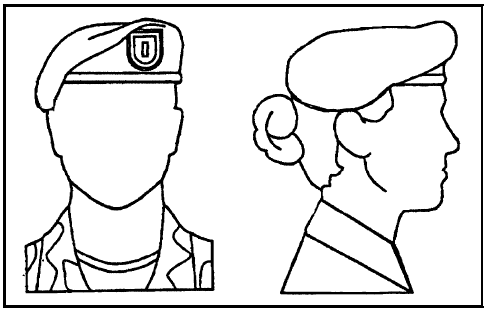The Beret
The beret is the basic headgear for utility uniforms in garrison environments. The beret is not worn in the field, in training environments, or in environments where the wear of the beret is impractical, as determined by the commander. Additionally, the beret is not worn on deployments unless authorized by the commander. Soldiers being transferred from one organization to another may continue to wear the beret and flash of the former unit until they report for duty at the new organization.

The beret is worn so that the headband (edge binding) is straight across the forehead, one (1) inch above the eyebrows. The flash is positioned over the left eye, and the excess material is draped over to the right ear, extending to at least the top of the ear, and no lower than the middle of the ear. Soldiers will cut off the ends of the adjusting ribbon and secure the ribbon knot inside the edge binding at the back of the beret. When worn properly, the beret is formed to the shape of the head; therefore, soldiers may not wear hairstyles that cause distortion of the beret.
Soldiers who are not assigned to units or positions authorized wear of the tan, green, or maroon berets will wear the black beret. This includes senior and junior Reserve Officer Training Corps (ROTC) instructors, unless otherwise indicated. Soldiers are issued the black beret upon assignment to their first permanent duty assignment after the completion of initial entry training or officer/warrant officer basic courses. Cadets and officer/warrant officer candidates will not wear the black beret. Split-option soldiers or soldiers in the simultaneous membership program will wear the black beret only when performing duties with their units, and they will wear the patrol cap with the BDU, when in a cadet or trainee status.
Soldiers who have not been issued or who do not wear the black beret will wear the patrol cap with the BDU. In those cases where beret sustainment levels are not sufficient for turn-in and reissue of unserviceable berets, the commander can authorize the temporary wear of the patrol cap until the beret can be replaced. The Army flash is the only flash authorized for wear on the black beret, unless authorization for another flash was granted before the implementation of the black beret as the standard Army headgear (for example, Opposing Forces elements).
Ranger Tan Beret
Soldiers assigned to the following units are authorized wear of the Ranger tan beret. Soldiers will wear the approved flash of the unit to which they are assigned:
-
75th Ranger Regiment.
-
Ranger Training Brigade.
-
Ranger-qualified soldiers in the following units or positions, if they previously served in the 75th Ranger Regiment.
-
US Special Operations Command.
-
US Army Special Operations Command.
-
US Special Operations Command Joint Task Force.
-
Theater Special Operations Command.
Green Beret
If approved by local commanders, all Special Forces-qualified soldiers (those carrying the Special Forces MOSs of 18A or 180A, CMF 18, and CSMs reclassified from 18Z to 00Z) are authorized to wear the Green Beret. This includes ROTC instructors and those attending training at an Army service school in a student status. Special Forces (SF) soldiers will wear the approved flash of the unit to which they are assigned. Special Forces soldiers who are assigned to an organization without an approved flash will wear the generic SF flash (the flash approved for soldiers assigned to SF positions, but not assigned to SF units).
Maroon Beret
All soldiers assigned to airborne units whose primary missions are airborne operations wear the maroon beret. The airborne designation for a unit is found in the unit modification table of organization and equipment (MTOE). Other soldiers authorized to wear the maroon beret are as follows:
-
Active Army advisors to reserve airborne units on jump status.
-
Soldiers assigned to the airborne departments of the US Army Infantry School and the US Army Quartermaster School.
-
Soldiers assigned to long-range surveillance detachments designated as airborne.
-
Soldiers assigned to the airborne/airlift action office.
-
Recruiters of the Special Operations Recruiting Company (SORC), US Army Recruiting Command, will wear the USASOC flash.
-
Soldiers assigned to the airborne procurement team.
-
Soldiers assigned to 55th Signal Company Airborne Combat Camera Documentation Team.
-
Soldiers assigned to 982d Combat Signal Company airborne platoons.
-
Soldiers assigned to rigger detachments.